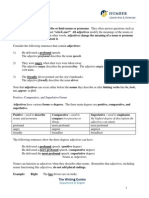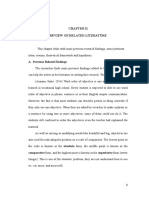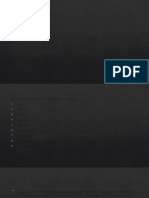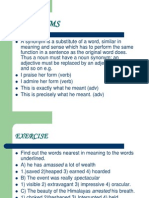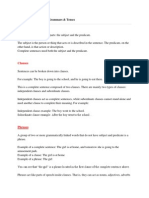Ren PDF
Ren PDF
Uploaded by
amazouzi lamyaCopyright:
Available Formats
Ren PDF
Ren PDF
Uploaded by
amazouzi lamyaOriginal Title
Copyright
Available Formats
Share this document
Did you find this document useful?
Is this content inappropriate?
Copyright:
Available Formats
Ren PDF
Ren PDF
Uploaded by
amazouzi lamyaCopyright:
Available Formats
Adjectives
Adapted from The Little, Brown Handbook, 11th Edition, Contributors Dayne Sherman,
Jayetta Slawson, Natasha Whitton, and Jeff Wiemelt, 2010, 315-326.
Prepared by the Southeastern Writing Center. Last updated July, 2011.
An adjective modifies a noun or pronoun by providing descriptive or specific detail. Unlike adverbs, adjectives do not modify
verbs, other adjectives, or adverbs. Adjectives usually precede the noun or pronoun they modify. Adjectives do not have to
agree in number or gender with the nouns they describe. Adjectives answer the following questions: What kind?, How many?,
or Which ones?
Example: Tom bought a used car. (used describes what kind of car Tom bought.)
Sally baked ten pies for the school bake sale. (ten tells how many pies Sally baked.)
Bob climbed that tree in the backyard. (that specifies which tree Bob climbed.)
Types of Adjectives
Descriptive Adjectives
A descriptive adjective names a quality of the noun or pronoun that it modifies.
Example: brown dog bigger house fluffy cat
Proper Adjectives
A proper adjective is derived from a proper noun.
Example: French class Spanish food European car
Limiting Adjectives
A limiting adjective restricts the meaning of the word it modifies.
Example: that car this room the tree
Interrogative Adjectives
An interrogative adjective is used to ask a question.
Example: Whose book is this?
Coordinate Adjectives
A coordinate adjective consists of two or more adjectives separated by a comma instead of by a coordinating
conjunction.
Example: a cold, rainy day
To determine if you can replace the coordinating conjunction with a comma, see if the adjectives can be reversed or if
and can be added between the adjectives without changing the meaning. If the adjectives can be reversed, they are
coordinate and a comma can be used.
Example: The clowns arrived in a bright, shiny car.
The clowns arrived in a shiny, bright car. (Reversing bright and shiny does not change the
meaning.)
The clowns arrived in a bright and shiny car. (Adding and between bright and shiny does not
change the meaning.)
Southeastern Writing Center
Celebrating the Writer’s Voice
383 D. Vickers Hall
(985) 549-2076 ~ writing@selu.edu
http://www.selu.edu/acad_research/programs/writing_center
However, if the adjectives cannot be reversed or if and cannot be used, a comma cannot be used.
Example: The clowns arrived in two colorful cars.
The clowns arrived in colorful two cars. (Reversing two and colorful changes the meaning.)
The clowns arrived in two and colorful cars. (Adding and between two and colorful changes the
meaning.)
Compound Adjectives
Compound adjectives consist of two or more words that function as a unit. Depending on its position within the
sentence, the compound adjective is punctuated with or without a hyphen. When a compound adjective comes before
the noun it modifies, use a hyphen to join the adjectives. When a compound adjective follows the noun it modifies, do
not use a hyphen to join the adjectives.
Example: She is taking a class on nineteenth-century literature. (The adjective nineteenth-century precedes
the noun literature so a hyphen is used.)
She is studying literature from the nineteenth century. (The adjective nineteenth century comes
after the noun literature so no hyphen is used.)
Determiners as Adjectives
Determiners, such as articles, pronouns, and numbers, can function as adjectives. When a determiner is used as an
adjective, it restricts the noun it modifies, like a limiting adjective. Determiners functioning as adjectives tell Which
one?, How many?, and Whose?
Articles (a, an, the)
Possessive pronouns (my, our, your, his, her, its, their)
Relative pronouns (whose, which, whichever, what, whatever)
Demonstratives (this, these, that, those)
Indefinite pronouns (any, each, other, some, etc.)
Cardinal Numbers (one, two, three, etc.)
Ordinal Numbers (last, first, second, etc.)
Possessive proper nouns (Bob’s, Sarah’s)
Example: Bob’s house is only three blocks from that house. (Bob’s answers the question: Whose house? Three
answers the question: How many blocks? That answers the question: Which house is three blocks from
Bob’s house?)
Placement and Order of Adjectives
A single noun can be described as a list of adjectives. When more then one adjective is used to modify a noun, it is important to
consider the order in which the adjectives appear. Generally, the adjectives most important in completing the meaning of the noun
are placed closest to the noun. Following is the usual order of adjectives in a series:
1. Determiners: articles (a, the), demonstratives (this, those), and possessives (his, our, Mary’s, everybody’s), amounts
(one, five, many, few), order (first, next last)
2. Coordinate adjectives (subjective evaluations or personal opinions): nice, nasty, packed, pitiful
3. Adjectives describing size: big, huge, little, tiny
4. Adjectives describing shape: long, short, round, square
5. Adjectives describing age: young, old, modern, ancient
6. Adjectives describing color: blue, green, red, white
7. Adjectives describing nationality: Italian, French, Japanese
8. Adjectives describing architectural style or religion: Greek, Gothic, Catholic, Jewish, Muslim
9. Adjectives describing material: cardboard, plastic, silver, gold
10. Nouns functioning as adjectives: soccer ball, cardboard box, history class
Example: a big brick house (article, size, and material)
these old brown cardboard boxes (demonstrative, age, color, material)
a beautiful young Italian woman (article, personal opinion, age, nationality)
Using Adjectives
Adjectives as Subject Complements
The subject complement is a word that follows a linking verb and modifies the sentence’s subject, not its verb. Linking
verbs: appear, become, believe, feel, grow, smell, seem, sound, remain, turn, prove, look, taste, and the forms of the verb to
be.
Example: The crowd appeared calm. (The linking verb appeared links the noun the subject crowd with the adjective
calm)
Adjectives as Object Complements
The object complement is a word that follows a sentence’s direct object and modifies that object and not the verb. An object
complement answers the question what? after the direct object.
Example: Bob considered the experiment a success. (Success is the object compliment that modifies the sentences
direct object experiment.)
Adjectives with Past and Present Participle Verbs
Adjectives are frequently formed by using the past participle (-ed, -t, or -en) and the present participle (-ing) verb forms.
Example: The group of children scared the sleeping dog. (Sleeping describes the baby.)
The students refused to eat the dried fruit. (Dried describes the cookies.)
You might also like
- English Grammar All You Need To KnowDocument22 pagesEnglish Grammar All You Need To KnowDavid Fueter0% (1)
- AdjectiveDocument10 pagesAdjectiveTC Nelinho CandidoNo ratings yet
- Types of AdjectivesDocument3 pagesTypes of AdjectivesJose Luis Beltran TimoteNo ratings yet
- AdjectivesDocument3 pagesAdjectivesBernard Catampongan IrincoNo ratings yet
- Adjectives (Guardado Automaticamente)Document9 pagesAdjectives (Guardado Automaticamente)Babucho DiasNo ratings yet
- AdjectivesDocument8 pagesAdjectivesmackycharm.carduzaNo ratings yet
- Adjectives-Olga Amosse Sinturao ZauiaDocument10 pagesAdjectives-Olga Amosse Sinturao ZauiachiruaflaviopedrojoneNo ratings yet
- NumberDocument12 pagesNumberWalter diasNo ratings yet
- Adjective Dan Jenis JenisnyaDocument2 pagesAdjective Dan Jenis JenisnyaHeruNo ratings yet
- Parts of SpeechDocument9 pagesParts of SpeechAbbbas100% (1)
- 11+ Types of Adjectives Used in English (With Examples) • 7ESLDocument18 pages11+ Types of Adjectives Used in English (With Examples) • 7ESLaymkurd11No ratings yet
- Chapter IiDocument19 pagesChapter IiNurhasanah SasmaliaNo ratings yet
- Parts of Speech GomezDocument25 pagesParts of Speech GomezsingcosweindinglasaNo ratings yet
- THP Practice 2Document13 pagesTHP Practice 2Dewi Astuti Purnama SariNo ratings yet
- Adjectives PDFDocument3 pagesAdjectives PDFDavid OrtizNo ratings yet
- Meaningful Building-Block of Language: Name: Ajeng Yupika NIM: 1185030011 Class: 3ADocument7 pagesMeaningful Building-Block of Language: Name: Ajeng Yupika NIM: 1185030011 Class: 3AAjeng YupikaNo ratings yet
- Chapter IIDocument24 pagesChapter IINhinie IndasariNo ratings yet
- Mastering Adjectives in English With Examples - 7ESLDocument27 pagesMastering Adjectives in English With Examples - 7ESLYasiruNo ratings yet
- Parts of SpeechDocument13 pagesParts of Speechkaren.mella.azaNo ratings yet
- Types of Parts of Speech NounDocument20 pagesTypes of Parts of Speech NounNurul Aida NionsiNo ratings yet
- English Oh ReadDocument115 pagesEnglish Oh Readjoc3lyn_nNo ratings yet
- Parts of SpeechDocument37 pagesParts of SpeechMuhammad Umar NaheedNo ratings yet
- Parts of SpeechDocument19 pagesParts of Speechzafar iqbalNo ratings yet
- Essentials of CommunicationDocument71 pagesEssentials of CommunicationAparajita RoyNo ratings yet
- AdjectivesDocument7 pagesAdjectivessavaelenaemanuelaNo ratings yet
- Modul 10: Blue, and Sharp Are Descriptive, and They Are All Examples of Adjectives. BecauseDocument6 pagesModul 10: Blue, and Sharp Are Descriptive, and They Are All Examples of Adjectives. BecauseChaerunnisa100% (1)
- English Basic GrammarDocument12 pagesEnglish Basic GrammaribnuamungNo ratings yet
- Parts of Speech - Full BookDocument45 pagesParts of Speech - Full BookAISHWARYA EDUCATIONNo ratings yet
- AdjectivesDocument4 pagesAdjectivesbarae sakleysiNo ratings yet
- Word ClassificationDocument28 pagesWord ClassificationmiftaNo ratings yet
- Sentences: Independent Clauses Act As Complete Sentences, While Subordinate Clauses Cannot Stand Alone andDocument9 pagesSentences: Independent Clauses Act As Complete Sentences, While Subordinate Clauses Cannot Stand Alone andThamizhman Mani100% (1)
- 8 Parts of Speech..Document4 pages8 Parts of Speech..Francis Hiro LedunaNo ratings yet
- English Assignment 1Document22 pagesEnglish Assignment 1katilabbuNo ratings yet
- Alfa Dito Ashari If Pagi B Test Bahasa InggrisDocument5 pagesAlfa Dito Ashari If Pagi B Test Bahasa InggrisRFz VisualizerNo ratings yet
- The Paper of Adjectives: Lecturer: Dra. Nurrochmi, M.PDDocument7 pagesThe Paper of Adjectives: Lecturer: Dra. Nurrochmi, M.PDNanda Mutiara SopandiNo ratings yet
- English Grammar 101Document10 pagesEnglish Grammar 101Talibovic TalibovNo ratings yet
- Road To English BetterDocument65 pagesRoad To English BetterEko Nurhadi SatrioNo ratings yet
- DeterminersDocument11 pagesDeterminerskingmuchangaNo ratings yet
- 1.0 Introductor-WPS OfficeDocument6 pages1.0 Introductor-WPS Officebenitamujinga84No ratings yet
- Gramma IDocument49 pagesGramma ITesfu HettoNo ratings yet
- Adjectives 22Document18 pagesAdjectives 22oussamaNo ratings yet
- Lesson 4 Adjectives LessonDocument29 pagesLesson 4 Adjectives LessonWane DavisNo ratings yet
- Bronex 0Document13 pagesBronex 0Bronex Paul MarcianoNo ratings yet
- Types of Nouns: Demonstrative PronounsDocument12 pagesTypes of Nouns: Demonstrative Pronounsanon_132777102No ratings yet
- Overview of Different Parts of SpeechDocument11 pagesOverview of Different Parts of Speechbenbelkacem.israaaNo ratings yet
- Parts of SpeechDocument48 pagesParts of SpeechAmna ShoukatNo ratings yet
- English Grammar 101Document8 pagesEnglish Grammar 101Chris Hogan100% (1)
- MAJOR 9 LESSON 1 - Parts of Speech in English GrammarDocument9 pagesMAJOR 9 LESSON 1 - Parts of Speech in English GrammarRegine Montiano Dela RosaNo ratings yet
- ASSIGNMENT 1 (Fix)Document17 pagesASSIGNMENT 1 (Fix)ihsanteeeyNo ratings yet
- Noun PhrasesDocument13 pagesNoun PhrasesLegends FunanzaNo ratings yet
- Adjective EnglishDocument20 pagesAdjective EnglishEyeBagsNiMikeyNo ratings yet
- English Pertemuan 1Document15 pagesEnglish Pertemuan 1Aurel ArafanyNo ratings yet
- Pronoun Group 3Document5 pagesPronoun Group 3Moh. Ridho FauzanNo ratings yet
- Lesson 8. Lexical Categories Introduction DiscussionDocument6 pagesLesson 8. Lexical Categories Introduction DiscussionColleen CastueraNo ratings yet
- Nouns, Pronouns, AdjectiveDocument24 pagesNouns, Pronouns, AdjectiveSF HongNo ratings yet
- All About GrammarDocument56 pagesAll About GrammarDeka Fab100% (1)
- Comprehensive English Grammar Guide: From Basics to Competitive ExcellenceFrom EverandComprehensive English Grammar Guide: From Basics to Competitive ExcellenceNo ratings yet














